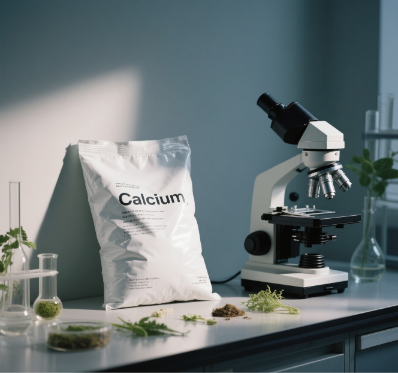Plants need nutrients to thrive, just as humans need vitamins and minerals. While most people know about the “big three” nutrients for plants—nitrogen (N), phosphorus (P), and potassium (K)—there’s a lesser-known nutrient that plays a critical role in keeping plants healthy: Calcium (Ca). This unassuming mineral is essential for building strong cell walls and helping plants withstand stress. However, despite being abundant in soil, many crops struggle to obtain sufficient calcium, resulting in costly issues such as rotting fruits and stunted growth. Let’s explore the fascinating world of calcium in plant nutrition and learn how to ensure that plants get the calcium they need.
Why calcium is a plant’s best friend
Imagine calcium as the construction foreman in a plant’s body. It:
- Builds strong foundations: It acts like “cement” in cell walls, binding a sticky substance called pectin together to create rigid structures. Without calcium, cells become weak and prone to cracking. Think of a tomato with ugly black spots on the bottom (a condition called blossom-end rot) or an apple with bitter pits.
- Keeps cell membranes leak-proof: Calcium acts as a sealant that prevents cell membranes from leaking vital substances. This is crucial during times of stress, such as drought or extreme temperatures, when leaky membranes can be disastrous.
- Acts as a communication officer: Calcium acts as a messenger inside cells, relaying signals that help plants respond to threats. For instance, during a drought, calcium helps plants close tiny pores (stomata) to conserve water.
- Strengthens defenses: Calcium boosts a plant’s immune system by activating enzymes that protect against diseases and environmental stressors, such as cold, heat, and salt.
The Great Calcium Dilemma: Why Plants Can’t Always Get Enough
Here’s the puzzle: Although calcium is often present in soil, plants frequently suffer from a calcium deficiency. Why? Several factors conspire against them:
- It’s stuck in traffic: Calcium moves through plants primarily via water flow in the xylem vessels. This means calcium can only travel upward, not downward or sideways. Consequently, fruits and roots, which have little water flow, often miss out.
- It gets stuck in the soil. Calcium can become “locked up” in the soil as insoluble compounds, such as calcium carbonate, or it can be tied up by competing elements, like potassium or ammonium.
- Plants can’t recycle it: Unlike nitrogen or potassium, calcium cannot be moved from older leaves to new growth. Once calcium is used to build a cell wall, it’s stuck there.
The Telltale Signs of Calcium Deficiency
If your plants show these symptoms, they might be crying out for calcium:
- Leaves: Curled or distorted tips, yellowing edges (chlorosis), or burned-looking spots.
- Fruits and flowers: – Blossom-end rot (black, sunken areas) in tomatoes, peppers, and eggplants; Cracked citrus fruits; or poor fruit development
- Roots: Stunted, brown, or rotting tips.
Saving Your Plants: Smart Strategies to Supply Calcium
The good news? With the right strategies, you can help your plants overcome calcium deficiencies.
- Choose the right calcium “delivery service”:
– Foliar sprays (like chelated calcium): These sprays deliver calcium directly to leaves and fruits, bypassing soil issues. Think of it as giving a plant an IV of calcium. Products such as calcium amino acid chelates and sugar alcohol chelates are highly effective.
– Soil amendments: For long-term solutions, use gypsum (calcium sulfate) in acidic soils. Avoid lime (calcium carbonate) unless your soil is very acidic because it can raise the pH level too high.
- Time it right:
– Before flowering: Apply calcium early to ensure strong cell development in future fruits.
– During fruit expansion: This is a critical time to prevent disorders like blossom-end rot.
– After harvest: Dip fruits, such as apples, in a calcium chloride solution to extend their shelf life.
- Team up with boron: Boron is calcium’s best buddy! It helps calcium move through cell walls. Mix a small amount of borax, a boron source, with calcium sprays for an extra boost (e.g., 0.2% borax + 2% calcium chloride).
- Think beyond calcium: Add humic acids to improve soil calcium availability and silicon to strengthen plant transport systems.
The Future of Calcium in Farming
Science is innovating solutions:
- Nano-fertilizers: These tiny calcium particles, wrapped in materials like chitosan, can more easily sneak into plant tissues.
- Gene-edited crops: Scientists are developing plants with enhanced calcium transporters.
- Smart sensors: Future farms may use AI-powered sensors to detect calcium deficiencies in real time.
Conclusion: Don’t Let Calcium Be the Weakest Link
Calcium is not just a nutrient; it’s a plant’s silent bodyguard. Understanding its importance, recognizing deficiency signs, and using smart supplementation strategies can help your crops grow stronger, resist stress, and produce healthier, longer-lasting harvests. The next time you see a perfect, rot-free tomato or a crisp apple, remember that calcium played a starring role behind the scenes!









